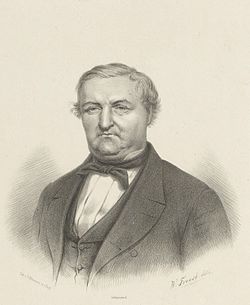Eeltsje Halbertsma
| Eeltsje Hiddes Halbertsma | |
|---|---|
 |
|
| Born | October 8, 1797 Grou (Netherlands) |
| Died | March 22, 1858 (aged 60) Grou (Netherlands) |
| Occupation | physician, poet, writer |
| Language | West Frisian |
| Nationality | Dutch |
| Period | 19th century |
| Genre | poetry, short stories |
| Literary movement | Romanticism |
| Notable works |
Rimen en Teltsjes De Alde Friezen |
| Years active | 1822–1858 |
| Spouse | Baukje Fockens |
| Children | 2 sons (Hidde and Liuwe), 2 daughters (Ruerdtsje and Anna) |
Eeltsje Hiddes Halbertsma (Frisian form), pron. [ˈeːlʧǝ ˈhɪdəs ˈhɔlbǝtsma] (the r is silent); Dutch form: Eeltje Hiddes Halbertsma, pron. [ˈeːlcǝ ˈhɪdəs ˈhalbǝrtsma] (Grou, October 8, 1797 – there, March 22, 1858), was a Dutch Frisian writer, poet and physician, and the youngest of the Halbertsma Brothers. He became well-known when he and his elder brother Justus published the poetry and short story collection De Lapekoer fan Gabe Skroar in 1822. Afterwards, this work was continually expanded, and also came to include contributions by a third brother, Tsjalling, until all the Halbertsma Brothers' prose and poetry was posthumously collected in 1871 to become the famous work Rimen en Teltsjes. This book played a role of crucial importance in the development of a new literary tradition after Western Frisian had been used almost exclusively as a spoken language for three centuries. Of the three Brothers Halbertsma, Eeltsje was probably the most talented, en especially his poetry is still very much admired. His oeuvre included the poem De Alde Friezen, which later became the national anthem of the Western Frisian people.
Eeltsje Hiddes Halbertsma was born on October 8, 1797, in his parents' house on Kowemerk ("Cow Market") street in the village of Grou, in the central part of the Dutch province of Friesland. He was the fourth son of the baker and small-time merchant Hidde Joasts Halbertsma (1756–1809) and his wife Ruerdtsje (or Riurtk) Tsjallings Binnerts (1767–1809). He had three elder brothers: Justus ("Joast") (1789–1869),Tsjalling (1792–1852), and Binnert (1795–1847). Two children who were born later died in early childhood, the little boy in 1803, and the little girl in 1805. The brothers were very close, possibly as a consequence of the fact that both their parents died at a relatively young age in 1809, when Eeltsje was only eleven years of age. Justus, Tsjalling and Eeltsje, who, as authors, became known as the Brothers Halbertsma later in life, were much like their father, while Binnert more resembled their mother.
...
Wikipedia
